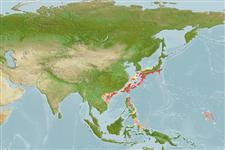Teleostei (teleosts) >
Eupercaria/misc (Various families in series Eupercaria) >
Labridae (Wrasses) > Cheilininae
Etymology: Cirrhilabrus: Latin, cirrus = curl fringe + Greek, labros = furious (Ref. 45335); isosceles: Named for the distinctive triangle of color on the midportion of the caudal fin; noun in apposition.
Environment: milieu / climate zone / depth range / distribution range
Ecology
Marine; reef-associated; depth range 24 - 60 m (Ref. 108439). Subtropical; 22°C - 27°C (Ref. 130608)
Western Pacific: Japan (Izu-Oshima), south to the Ryukyu Archipelago (Yaeyama Islands and Okinawa), Taiwan (Green Island), and the Philippines.
Size / Weight / Age
Maturity: Lm ? range ? - ? cm
Max length : 10.0 cm SL male/unsexed; (Ref. 130608)
Short description
Identification keys | Morphology | Morphometrics
Dorsal spines (total): 11; Dorsal soft rays (total): 9; Anal spines: 3; Anal soft rays: 9. This species is distinguished by the following characters: D XI,9; A III,9 except holotype with III,8; pectoral-fin rays 14-15; lateral line interrupted with 16-17 + 6-8 scales; median predorsal scales 4-5; 2 horizontal scale rows on cheek below eye; gill rakers 15; body depth 29-34% SL; head length 29-36% SL; snout length 9-11% SL; caudal fin of terminal-phase (TP) male is broadly lanceolate, i.e. rhomboidal with an extension of central rays; pelvic fins are relatively short, not reaching anal-fin origin when depressed; colour of TP male in life orange-yellow dorsally suffusing to lavender ventrally; a bright pink-to-purplish stripe at rest and dead, but blue in life and especially when displaying, extending posteriorly from upper orbit across head before making an oblique downward slant behind pectoral-fin base, and then continuing just below mid-lateral line to base of caudal fin; a prominent long mid-dorsal-fin basal dark spot, with a mostly lavender blotch on upper body below spot; colour of initial-phase fish mainly uniformly orange with faint stripes along dorsum and weak manifestation of medial stripe (Ref. 108439).
Occurs in areas with flat or gently sloping bottoms with scattered low outcrops of rock and coral (Ref. 108439).
Life cycle and mating behavior
Maturity | Reproduction | Spawning | Eggs | Fecundity | Larvae
Tea, Y.-K., H. Senou and B.D. Greene, 2016. Cirrhilabrus isosceles, a new species of wrasse (Teleostei: Labridae) from the Ryukyu Archipelago and the Philippines with nores on the C. lunatus complex. J. Ocean Sci. Found. 21:18-37. (Ref. 108439)
IUCN Red List Status (Ref. 130435: Version 2024-1)
Threat to humans
Harmless
Human uses
Fisheries: commercial; aquarium: commercial
Tools
Special reports
Download XML
Internet sources
Estimates based on models
Phylogenetic diversity index (Ref.
82804): PD
50 = 0.5000 [Uniqueness, from 0.5 = low to 2.0 = high].
Bayesian length-weight: a=0.01585 (0.00700 - 0.03587), b=2.95 (2.76 - 3.14), in cm total length, based on LWR estimates for this (Sub)family-body shape (Ref.
93245).
Trophic level (Ref.
69278): 3.4 ±0.4 se; based on size and trophs of closest relatives
Resilience (Ref.
120179): High, minimum population doubling time less than 15 months (Preliminary K or Fecundity.).
Fishing Vulnerability (Ref.
59153): Low vulnerability (10 of 100).
